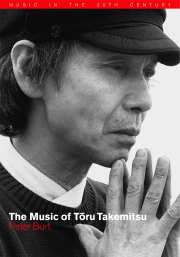Book contents
- Frontmatter
- Contents
- Acknowledgements
- Note on conventions
- Introduction
- 1 Pre-history: how Western music came to Japan
- 2 Music and ‘pre-music’: Takemitsu's early years
- 3 Experimental workshop: the years of Jikken Kōbō
- 4 The Requiem and its reception
- 5 Projections on to a Western mirror
- 6 ‘Cage shock’ and after
- 7 Projections on to an Eastern mirror
- 8 Modernist apogee: the early 1970s
- 9 Descent into the pentagonal garden
- 10 Towards the sea of tonality: the works of the 1980s
- 11 Beyond the far calls: the final years
- 12 Swimming in the ocean that has no West or East
- Notes
- List of Takemitsu's Works
- Select bibliography
- Index
3 - Experimental workshop: the years of Jikken Kōbō
Published online by Cambridge University Press: 18 August 2009
- Frontmatter
- Contents
- Acknowledgements
- Note on conventions
- Introduction
- 1 Pre-history: how Western music came to Japan
- 2 Music and ‘pre-music’: Takemitsu's early years
- 3 Experimental workshop: the years of Jikken Kōbō
- 4 The Requiem and its reception
- 5 Projections on to a Western mirror
- 6 ‘Cage shock’ and after
- 7 Projections on to an Eastern mirror
- 8 Modernist apogee: the early 1970s
- 9 Descent into the pentagonal garden
- 10 Towards the sea of tonality: the works of the 1980s
- 11 Beyond the far calls: the final years
- 12 Swimming in the ocean that has no West or East
- Notes
- List of Takemitsu's Works
- Select bibliography
- Index
Summary
Takemitsu's first exposure to public criticism may ultimately have ended in tears, but the Shinsakkyokuha evening which featured his compositional début was not without its positive side. In the green room after the performance, Takemitsu met two figures who were to become important allies: the composer Jōji Yuasa (1929–), and the poet and music critic Kuniharu Akiyama (1929–96). It was as a result of encounters with these and other kindred spirits over the course of the next year or so that a decision was made to found a new artistic alliance that would reflect their common aesthetic ideals. Thus it was that in September 1951 Takemitsu and eight idealistic young colleagues launched the new organisation which was to become such a colourful feature of the Japanese avant-garde landscape for the next six years; an organisation which, at the suggestion of the inspirational figure behind much of its activity, Shūzo Takiguchi, was given the name ‘Experimental Workshop’: Jikken Kōbō.
This switch of loyalties from the Shinsakkyokuha (from which both Takemitsu and Suzuki withdrew their membership in the following year) was a significant one for Takemitsu. The new grouping differed from the old in two important respects, both of which were to have far-reaching repercussions for Takemitsu's artistic development. First, it had a decidedly anti-academic bias – in fact, it seems that any kind of formal musical education was a barrier to membership, and this naturally helped consolidate Takemitsu's position as an outsider to the highly conservative world of the institutional Japanese academic establishment at this period.
- Type
- Chapter
- Information
- The Music of Toru Takemitsu , pp. 39 - 49Publisher: Cambridge University PressPrint publication year: 2001



